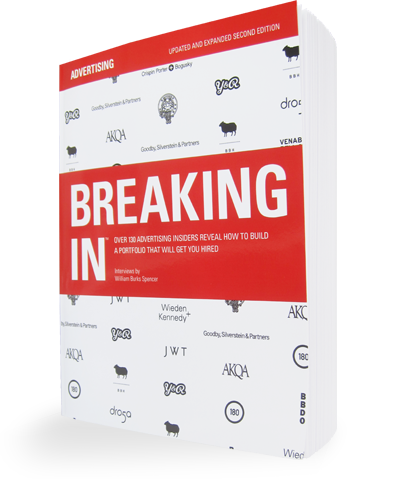In case you missed it, check out some great work from David Carter.
[ … ]
WS: Do you have any other advice that you’d give to someone who is just starting out?
DC: Putting a book together is a lot different today. I don’t think people actually have physical books anymore, really. They just do everything online. I would say that fewer “great ideas” is better than more “okay ideas.” I would try to solve some tough strategic problems. I think anybody can do a good ad for highlighter pens, or White-out, or stuff like that. I think it’s more important if you can work on harder things. Unless it’s just such a great idea no matter who it’s for.
This is just my personal taste but I gravitate toward simpler [ideas]—the simpler the better—and more so in print than anything else. If it’s a really “designy” thing, I don’t have time for it, and I think most consumers don’t have a lot of time for that anymore, so I think the ideas have to be more simple and clear. What else? It certainly seems like, in this day and age, having interactive ideas is very important too.
WS: Do you have any thoughts on presenting those?
DC: If you don’t actually know how to build a site and it is just purely a spec thing, just comp a couple of the pages so you get what the idea is. As long as it is communicated clearly, I think [that’s okay].
WS: It seems like a lot of people are trying to do 360 campaigns that have tons of different elements. Do you have any thoughts on how to present those or what’s important with those kinds of things?
DC: Well, we struggle with that here on a daily basis—trying to present those kinds of ideas to clients—because they’re really hard to present unless you have a really good client who can see the bigness of the idea and say, “Oh yeah! Okay, I get it.” Because we’ve presented a lot of those kinds of things to clients and half an hour later you’re still talking because there are so many different elements. So I guess I would say, start with what the big idea is and then move into details. I think, certainly here and at other agencies and maybe even in student books now, I think you fall into the trap of trying to come up with every single little thing that the idea could translate into. I don’t think you necessarily need to do that as long as you have maybe three or four things where the idea is really clear and uses each medium to communicate that in the best way possible. So again, I think streamlining and keeping it simple is important so that, when somebody is clicking through the pages, they go, “Oh, yeah great TV spot,” “Oh, yeah great web film,” “Oh, yeah great event,” or whatever it happens to be. Just so it’s clear—that you can see the idea.
WS: When people come to see you in person, do they have a physical book, or at that point have you already seen their website?
DC: I think by that time you’ve seen it and you’re just kind of talking to them. It’s nice not to have to carry a big portfolio around.
WS: Okay. Anything else?
DC: Headhunters help. I don’t know, the books that I’ve seen lately are—even in the past year—they’re just too complex. I just clicked to it, and I didn’t want to even look at it. Simplify, simplify, simplify! What is the idea? Communicate the idea as clearly, simply, and quickly as possible. And pare it down. I mean, if you had nine awesome, awesome things, there’s no need for more.

Comments are closed.